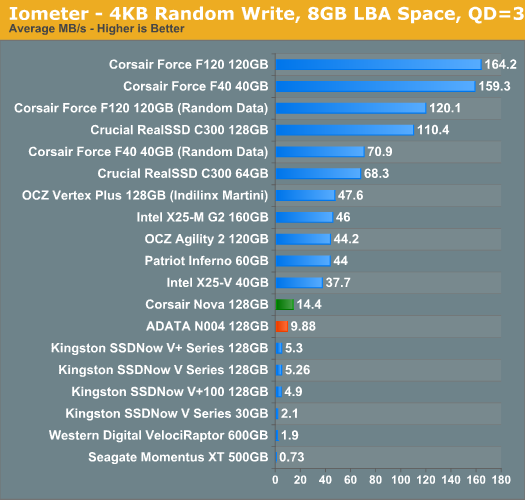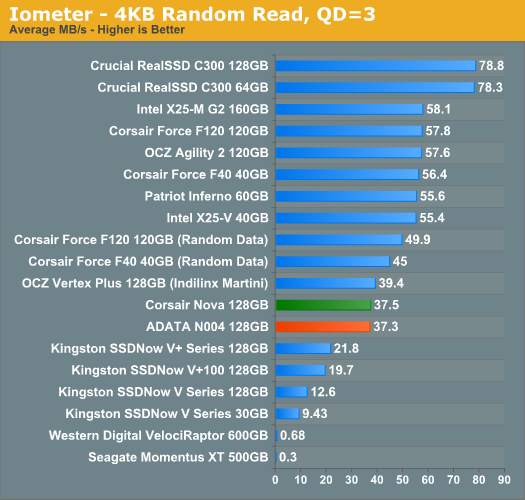ADATA N004 - SATA & USB 3.0 SSD Reviewed
by Rajinder Gill on November 29, 2010 12:38 PM ESTThe four corners of SSD performance are as follows: random read, random write, sequential read and sequential write speed. Random accesses are generally small in size, while sequential accesses tend to be larger and thus we have the four Iometer tests we use in all of our reviews.
Our first test writes 4KB in a completely random pattern over an 8GB space of the drive to simulate the sort of random access that you'd see on an OS drive (even this is more stressful than a normal desktop user would see). As we've explained in the comments in previous reviews, simulating the type of random access you see in a desktop workload is difficult to do. Small file desktop accesses aren't usually sequential but they're not fully random either. By limiting the LBA space to 8GB we somewhat simulate a constrained random access pattern, but again it's still more random than what you'd see on your machine. Your best bet for real world performance is to look at our Storage Bench charts near the end of the review as they accurately record and play back traces of real world workloads.
For our random access tests we perform three concurrent IOs and run the test for 3 minutes. The results reported are in average MB/s over the entire time. We use both standard pseudo randomly generated data (data is random within a write, but duplicated between writes) for each write as well as fully random data (data is random within a write and random across most writes) to show you both the maximum and minimum performance offered by SandForce based drives in these tests. The average performance of SF drives will likely be somewhere in between the two values for each drive you see in the graphs. For an understanding of why the type of data you write to SF drives matters, read our original SandForce article.

Our random read test is similar to the random write test however we lift the 8GB LBA space restriction:

The random read/write performance is where ADATA are having to rely on the unique connectivity aspect of the N004 as a selling point, because the Inidilinx Barefoot doesn't do well against drives with better controllers.










16 Comments
View All Comments
DigitalFreak - Monday, November 29, 2010 - link
No end-user upgradeable firmware = no salesemo - Monday, November 29, 2010 - link
There are a whole lot of other SSDs on the market that make no sense but exactly why did a barefoot one appeared on AT is puzzling.This product might have had relevance a year ago but not today
ggathagan - Monday, November 29, 2010 - link
Relevance?Other than the OCZ Enyo, Iomega and the forthcoming Kingston that Rajinder mentioned, how many other external SSD's with a USB 3 interface are out there?
How about any other SSD that can be used both as an internal SATA drive and an external drive with a USB 3 interface?
semo - Monday, November 29, 2010 - link
It may have some relevance as a USB 3.0 drive (very niche considering you can buy very fast and slightly smaller USB 3.0 pendrives) but it is totally pointless as an internal drive. It would have to drop to at least half the price of a SF or Intel controller powered drive before it makes sense as a SATA drive.It is a barefoot drive... I don't know how were they priced in the states but here in the UK barefoot drives used to cost MORE than the X25s. I really hate Indilinx for failing to provide a decent competition when it was needed the most. They deserve all the ass whopping coming their way...
bji - Monday, November 29, 2010 - link
Sounds like you're speaking from a context of having a bone to pick with Indilinx rather than an objective analysis of the drive.The performance looks decent in many respects and this drive could be just fine for many different types of workloads. Indilinux-hating aside, I don't see how anyone could possibly claim that there is no value to this drive. And your comments about the Indilinx controller drives being half the value of same-size Sandforce and Intel controller drives is way off-base.
Also, I'd like to know what pen drives you are talking about that can read/write hundreds of megabytes per second sequentially, and read 37 megabytes per second randomly.
semo - Monday, November 29, 2010 - link
http://www.engadget.com/2010/11/26/super-talent-us...This is a very fast USB 3.0 pendrive and is smaller than the reviewed product here (note that I never said it is faster).
Don't tell me that you would prefer a barefoot SSD over SF, Intel or Toshiba? Many people have said that there is a tangible difference of performance between the vertex (1) and x25s and considering that they were more expensive (at least here in the UK), I fail to realize the relevance of barefoot controllers in this day and age. We're yet to see how the updated barefoot behave but with imminent updates coming from Intel and SF, I don't think this would matter much.
bji - Tuesday, November 30, 2010 - link
You said before that the drive was "totally pointless as an internal drive". That is the comment that I have issue with. It is not pointless, it just has performance and cost characteristics that make it suitable for some workloads and not others.Also, the pen drive you linked to costs $599 for 128 GB. And the only customers reviews I could find on it are not positive (losing connectivity with the device repeatedly, possibly due to USB power draw issues). So I don't really think you can use that drive as any kind of foil to compare the Indilinx drive against.
piroroadkill - Monday, November 29, 2010 - link
The way I remember it, Indilinix DID provide relief in a way, and that was relief from the horror of the jmicron drives, and not necessarily the Intel ones.bji - Monday, November 29, 2010 - link
Yes, if there is a company that is worthy of your scorn, it is surely JMicron, and not Indilinx. JMicron really should have been sued out of existence for their faulty designs (not just SSDs either, their other controllers have been buggy and problematic also).Nataku - Tuesday, November 30, 2010 - link
no offense... but... how many users do you know that actually bothers with firmware update unless something is broken?I know I don't usually bother with it...